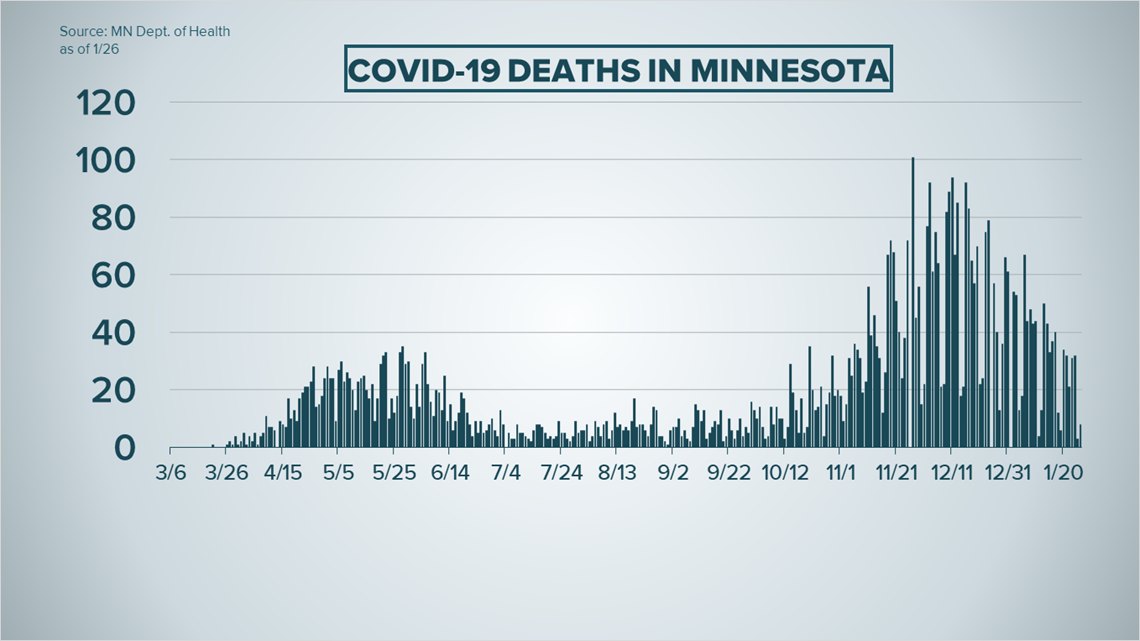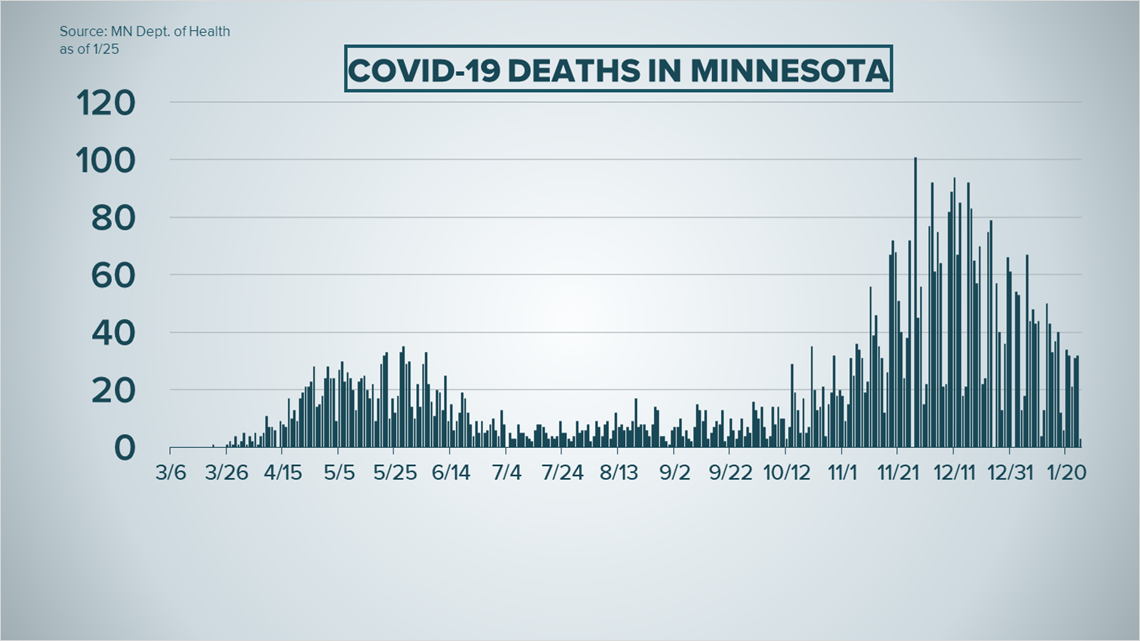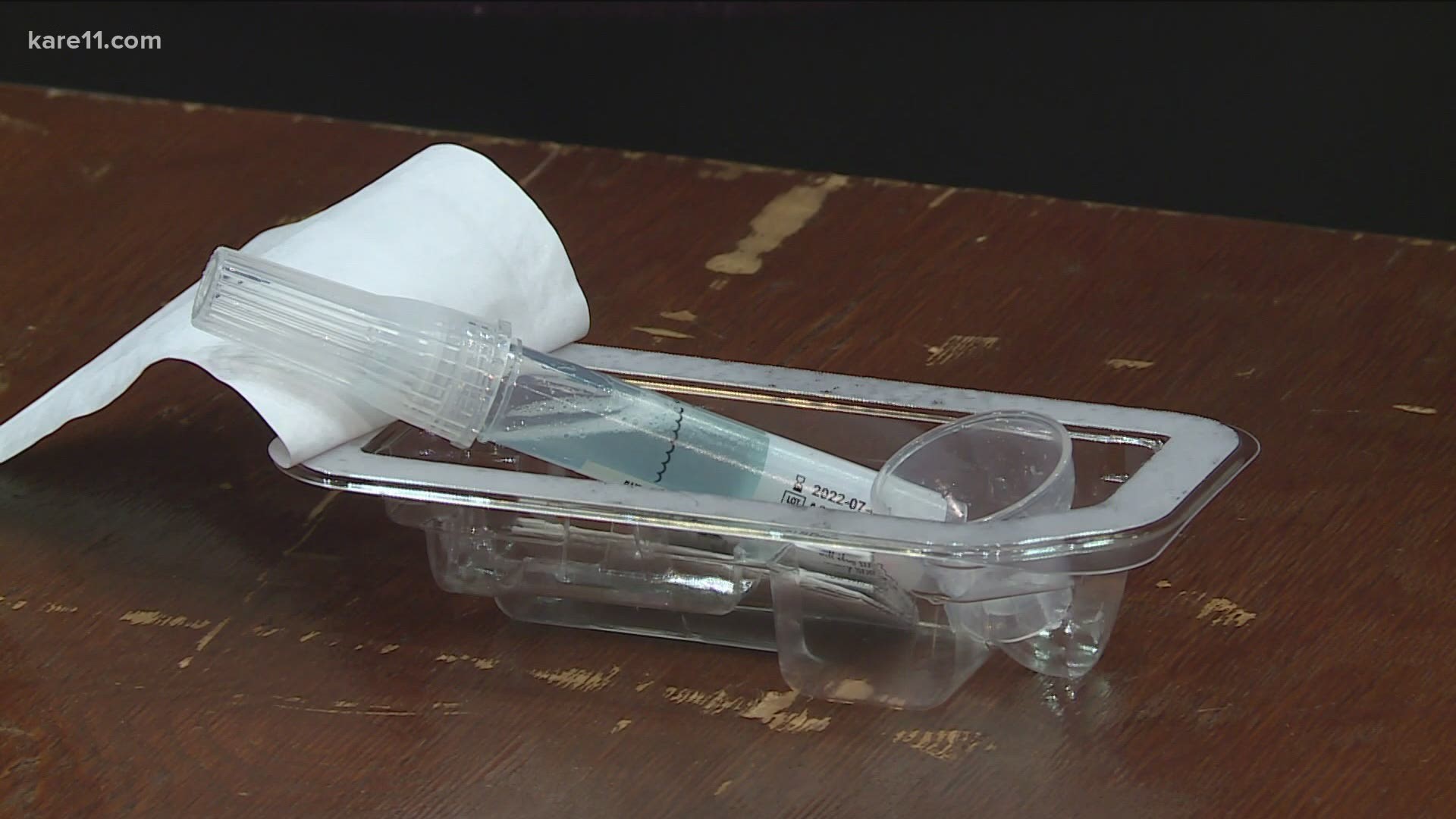ST PAUL, Minn. — Tuesday, Jan. 26
- New cases below 800, single-digit deaths for second consecutive day
- Heavy web traffic as vaccine lottery opens for people 65-plus
- First known case of Brazil COVID-19 variant in U.S. discovered in Minnesota
- State to hold mass vaccination event for educators in St. Paul
- State passes new vaccine milestone: more than 250,000 Minnesotans with at least one dose
2 p.m.
State health officials said the first discovery of a Brazilian variant of COVID-19 in Minnesota points to the importance of coronavirus testing, as the discovery was made through the state's ongoing variant testing.
"While this variant is thought to be more transmissible than the initial strain of the virus, it is not clear if the variant causes more severe disease," said Minnesota Department of Health (MDH) State Epidemiologist Dr. Ruth Lynfield.
Dr. Lynfield said the patient became ill the first week of January and was tested on Jan. 9. The patient spoke with MDH case investigators after receiving a positive COVID test, reporting recent travel to Brazil.
In addition to the Brazilian variant, Dr. Lynfield said eight cases of a variant first discovered in the U.K. have been found in Minnesota, but she believes more cases exist in the state.
"These cases show why it is important to limit travel during a pandemic," Dr. Lynfield said. "We know some people have circumstances where they really need to travel. It's important to watch for symptoms and follow public health guidance and use careful protective measures ... and to quarantine and get tested after travel."
Lynfield said widespread testing is an important tool to track what COVID-19 is doing in Minnesota. She said having fewer infections means the virus has less opportunity to evolve. Lynfield stressed the best way to slow the spread of the variant is with "tried and true prevention" methods that health officials have promoted throughout the pandemic.
MDH Assistant Lab Director Dr. Sarah Vetter said virus variants are common with any virus, and tracking those variants helps doctors learn more about virus transmission. Vetter said scientists are watching elements of the variants that could cause the virus to be more contagious.
"Based on what we know so far, Pfizer and Moderna vaccines will still have efficacy against the variants," Dr. Vetter said, noting that both vaccines can be modified if necessary, and that it is unlikely the vaccines will become completely ineffective.
Meanwhile, Minnesota's vaccine pilot program continues to accept pre-registration for people over the age of 65 through 5 a.m. Wednesday. MNIT commissioner Tarek Tomes said 180,000 people had pre-registered for week two the COVID-19 vaccine pilot program as of 1 p.m. and are now included on the waitlist, including 11,000 registrations carried over from the first week.
Tomes noted no vaccination slots were filled on Tuesday, though some users were confused after receiving a notification that they were placed on a "waitlist." All persons pre-registered are on the waitlist for a random selection process that will begin at 7 a.m. Wednesday, two hours after pre-registration closes, and those selected for a vaccine will be contacted to make a vaccine appointment.
People on the waitlist who are not selected for a vaccine on Wednesday will remain on the waitlist for later vaccine lottery selections as well, Tomes said. The state will not delete the remaining names and will carry those names over for the future.
Tomes encourages registrants who encountered errors that their address did not qualify for the program should reapply online and ensure their address entries are correct.
"There are no addresses in Minnesota that are not eligible for this," Tomes said.
11 a.m.
As Minnesota ramps up its efforts to vaccinate front line workers, educators and residents age 65 and over against COVID-19, numbers released Tuesday by state health officials suggests that cases and deaths continue to trend in the right direction.
Data from the Minnesota Department of Health (MDH) says 727 new cases of coronavirus were recorded in the past day, the second straight day cases have been below the 800 mark. The last time the state saw cases that low was Sept. 30, when 689 cases were reported.
The new cases were based on a very low volume of 10,929 tests (9,839 PCR, 1,090 antigen) performed in private and state labs. Health officials consider a positive PCR test a confirmed COVID case, while a positive antigen test is considered a probable case.
Minnesota has now recorded a total of 456,490 coronavirus cases since the pandemic began, with 19,226 of those cases based on antigen tests.
Another eight people have lost their lives to the virus, the second consecutive day that deaths were in single digits. The state's total fatalities due to COVID-19 now sit at 6,106.


The MDH vaccine dashboard says 284,441 people have received at least one dose, while 67,567 have completed the two-dose vaccine series. The state says 92% of the vaccine supplies received by health providers were administered to patients within seven days.
Hospital bed availability continues to improve, with 496 beds across the state currently being used to treat COVID patients. Of those beds, 100 are in ICU. Availability is tightest in the Twin Cities metro, with 4.5% of non-ICU hospital beds open, and 7.8% of ICU beds available for patients.
Total hospitalizations since the pandemic arrived in Minnesota have climbed to 24,014, with 4,995 of those patients requiring ICU care.
MDH says 440,596 people who at one time tested positive for the virus have recovered to the point they no longer require isolation.
Young adults make up the largest group of COVID cases, with those ages 20 to 24 accounting for 45,998 cases and three deaths, and their 25 to 29-year-old counterparts recording 41,048 cases and six deaths. The largest grouping of fatalities involves those 85 to 89, with 1,163 deaths in just 5,991 confirmed cases.
Hennepin County has recorded the most COVID activity in the state with 94,707 cases and 1,506 deaths, followed by Ramsey County with 40,752 cases and 750 deaths, Dakota County with 33,684 cases and 355 deaths, and Anoka County with 31,437 cases and 368 fatalities.
Cook County in northeastern Minnesota has reported the least COVID activity with 116 cases and zero deaths.
Monday, Jan. 25
2:30 p.m.
The U.S. Department of Health and Human Services (HHS) will provide the Minnesota Department of Health with more than $375 million to assist in the state's COVID-19 pandemic response.
According to a press release from U.S. Senator's Amy Klobuchar and Tina Smith, the funding is part of a $22 billion federal program to help states across the country.
“For more than ten months, Minnesotans have worked tirelessly to combat the pandemic. This much-needed additional funding will expand testing and help prepare communities for vaccine distribution. There is a light at the end of the tunnel, but we must continue to do everything we can to get communities the resources they need,” said Sen. Klobuchar in a press release.
"In the midst of the coronavirus pandemic, my priorities have been Minnesota's priorities—getting help to families, small businesses, schools, our health care system, and more," said Sen. Smith in a press release. "This funding will put real dollars behind testing, contact tracing, and vaccination efforts to help us get a better handle on the pandemic and reopen our hard-hit economy. But there’s much more we must do to lift up and support all communities in Minnesota during this difficult time. I stand ready to work with my colleagues and the new Biden Administration to lead an equitable and effective response to the pandemic."
According to the release, $324,608,098 will go towards COVID-19 testing, contact tracing, surveillance, containment and mitigation, while $50,958,885 will be allocated for other coronavirus vaccination activities.
2:15 p.m.
Gov. Tim Walz announced actions to help make COVID-19 vaccines more available statewide.
According to a press release from Gov. Walz's office, the new plans include a 72-hour goal for providers to administer 90% of their vaccine doses, and the remaining doses within one week. If a vaccine provider can't meet these goals, new vaccine allocations could be administered to that specific provider.
The other actions include a mass vaccination event for Minnesota educators, and a new system for allowing adults who are 65+ to sign up for vaccine appointments.
2 p.m.
Gov. Tim Walz held a news conference on Monday to unveil the Due North Education Plan for Minnesota, focused on equity in the state's educational system.
The plan prioritizes in-person education for as many students as is safely possible, expands academic opportunities, mental health services and out-of-school opportunities, and includes a one-time investment to help schools recover from pandemic enrollment loss. Walz's office says it will expand access to opportunities for students of color and Indigenous students, and students in greater Minnesota.
The plan will also involve launching a statewide family engagement model to support schools, and a statewide mentor program to support and retain teachers, according to Walz's office.
11 a.m.
Monday morning, the Minnesota Department of Health (MDH) reported the lowest numbers of both new COVID-19 cases and new deaths that the state has seen in months.
According to MDH, three people died of coronavirus across the state in the last 24 hours. That is the lowest single-day death toll Minnesota has reported since Oct. 12.
MDH also reported only 794 new cases on Monday. That includes 663 positive PCR test results, considered "confirmed" by MDH, and 131 antigen test results, considered "probable."
The last time Minnesota saw cases that low was Sept. 30, with 689 cases total.
Those statistics are excluding New Year's Day, when MDH did not report an update in observance of the holiday.


The latest data available on vaccine distribution on Monday showed that as of Sunday, 529,375 doses has been shipped to providers, 153,300 have been shopped for the CDC long-term care vaccination program, and 49.1% of Minnesota's doses have been used. As of Friday, nearly 267,000 Minnesotans had received at least one dose, and over 67,000 have received both doses.
Gov. Tim Walz announced changes to the Minnesota COVID-19 vaccination pilot program on Monday. Instead of having adults 65 and older sign up on a first-come, first-served basis, they can sign up at mn.gov/vaccine during a 24-hour window from Tuesday, Jan. 26 at 5 a.m. to Wednesday, Jan. 27 at 5 a.m. Then people will be drawn to receive a vaccine at random.
Walz also announced Monday that the state will hold a mass vaccination event for Minnesota educators, school staff and child care workers at Xcel Energy Center from Jan. 28 through Feb. 1. Appointments will be required, and must be made through the school districts, schools or employers.
Walz is expected to announce a "sweeping education plan" at 2 p.m. on Monday. KARE 11 will broadcast it live on air, on KARE11.com and on the KARE 11 YouTube page.
KARE 11’s coverage of the coronavirus is rooted in Facts, not Fear. Visit kare11.com/coronavirus for comprehensive coverage, and kare11.com/vaccine for answers to all of your questions about the race to get the U.S. vaccinated. Have a question? Text it to us at 763-797-7215. And get the latest coronavirus updates sent right to your inbox every morning. Subscribe to the KARE 11 Sunrise newsletter here. Help local families in need: www.kare11.com/give11.
The state of Minnesota has set up a data portal online at mn.gov/covid19.

